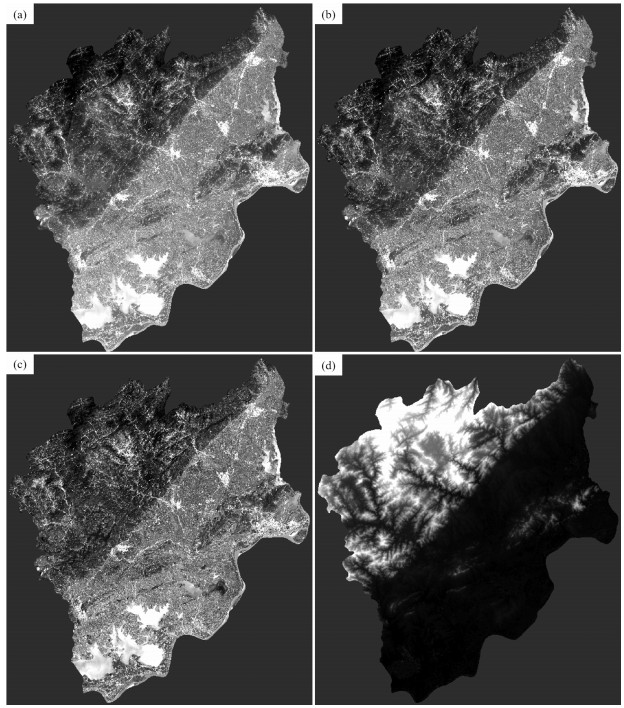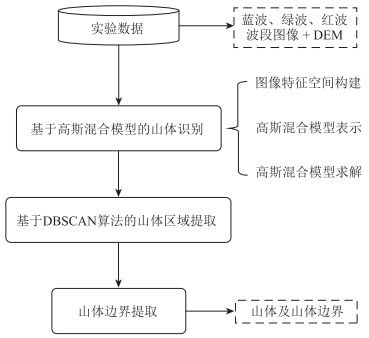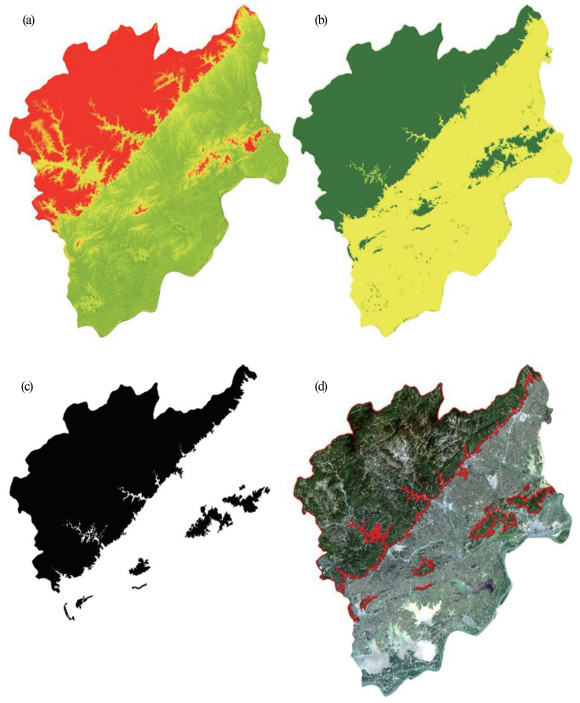Automatic monitoring of natural resource in Anqing City of Anhui Province based on statistical learning methods-a case study of mountains
-
摘要:
遥感作为一种可以快速、大范围获取地表覆盖信息的技术手段,为复杂的自然资源调查任务提供了可靠的数据来源。针对山体确界问题,以遥感卫星影像为数据支撑,采用非监督的统计学习方法,为山体特征建模。然后,采用DBSCAN算法和边缘检测思想,识别山体区域,并提取山体边界。该方法不依赖于人工标记真值,实现了山体边界的全自动识别。实验采用安庆市Landsat 8遥感卫星影像数据,有效识别了安庆市境内的山体,并提取山体边界。通过定性和定量化分析,验证了方法的可靠性,证明了遥感技术和统计学习理论在自然资源调查领域的应用潜力。该研究方法和结果能够为安庆市明确山体范围,界定山体的完整性与山体保护规划工作提供理论支撑。
Abstract:Remote sensing, a technology used for quickly and extensively acquisition of land cover information, provides a reliable data source for complex natural resource survey.Aiming at the problem of mountain boundary recognition, an unsupervised statistical learning method was proposed to extract mountain features using remote sensing satellite images for modeling of mountain features.Specifically, DBSCAN algorithm and edge detection ideas were used to identify the mountain area and extract the mountain boundary.This approach recognizes the mountain boundary automatically, which does not rely on marking the ground truth manually.In the experiment, the Landsat 8 remote sensing satellite image data of Anqing City were used to effectively identify the mountainous area and extract the boundaries of the mountains.Through qualitative and quantitative analysis, the reliability of the proposed method was verified.Moreover, it proved the application potential of remote sensing technology and statistical learning theory in the field of natural resource survey.
-
Keywords:
- natural resources /
- mountain /
- remote sensing /
- statistical learning /
- recognition /
- Anhui Province
-
雅鲁河断裂位于大兴安岭北段,由大兴安岭北段主脊向东坡延伸与嫩江断裂交汇,北起内蒙古牙克石市附近,沿免渡河和雅鲁河河谷展布,途经内蒙古免渡河镇、博克图镇、哈拉苏镇、卧牛河镇、扎兰屯市、成吉思汗镇,再向东南进入黑龙江省,经辗子山区、龙江县,终止于雅鲁河与嫩江交汇处,全长约300km,断裂总体走向NW—NNW,由多条NNW向、近SN向和近EW向断裂首尾相接(图 1-a)[1]。区域地质调查资料显示,雅鲁河断裂对免渡河和雅鲁河两侧的地势地貌及晚更新世以来的冲洪积物展布具有强烈的控制作用①②。现代地震资料显示,自1900年以来,雅鲁河断裂及其周边地区发生了多次中强度地震,均呈现浅源地震特征,震级主要分布在4~ 5.5级之间,发震时间主要为公元1923—1931年、1956年、1980—1981年,发震断层性质为走滑-逆断层[2-4]。自2008年龙江县Ms5.0级地震以来,雅鲁河断裂进入到新的活跃期,相继在扎兰屯市-牙克石市交界、鄂温克族自治旗、扎兰屯市、碾子山区发生6次小型浅源地震,2017年在扎兰屯市和碾子山区发生3次地震(Ms3.0~3.8,震源深度10~18km)。因此,雅鲁河断裂是大兴安岭地区典型的活动断层,其不仅对免渡河和雅鲁河流域晚更新世地质和地貌演化具有控制意义,也与现代地震活动密切相关。
前人对雅鲁河断裂周边的第四纪地质、古环境变迁、构造地貌、新构造运动等进行了大量调查①②③与研究[5-14],认为免渡河和雅鲁河发育2~3级阶地及一系列断裂活动的地貌遗迹,且雅鲁河断裂和嫩江断裂所夹的断块自中更新世以来存在3期抬升[14]。目前,主要通过雅鲁河周边地貌和晚更新世地质的调查与研究,推测雅鲁河断裂的活动特征,尚未找到断裂活动错切晚更新世以来松散堆积物的直接证据。近年来,笔者在内蒙古东部扎兰屯市附近开展地质调查工作中,在雅鲁河东侧的高位松散砂砾石层中发现雅鲁河断裂活动记录,该记录不仅可以厘定断层活动特征、限定断层活动时代,且可以结合相关经验公式,估测该记录反映的古地震特征,对区域活动构造研究、地震活动规律探索、地质灾害预警及重大工程规划意义重大。
1. 区域概况
1.1 地貌、地质概况
雅鲁河断裂活动记录发现于扎兰屯市成吉思汗镇北侧,位于雅鲁河断裂东南段(图 1-b)。该段行政区属黑龙江省碾子山区—内蒙古自治区扎兰屯一带,是大兴安岭东坡的山前地区,为松嫩平原与大兴安岭NE—NNE向隆起带的盆山过渡区,是中国东北地区盆山地貌形成、新构造运动、气候环境研究的重要位置[14]。区域地势整体呈西高东低、北高南低的特征,雅鲁河主河道由北向南呈NNW—近SN向展布。雅鲁河河谷两侧地势地貌和水系特征略显不同:东侧为起伏较小的台地,分支水系发育且延伸有限;西侧为起伏较大的丘陵,分支水系较发育且延伸较远,呈NW向和近EW向展布,较大的有雾大哈气河、库堤河、麒麟河等(图 1-b)。
大地构造位置上,该区位于古亚洲洋构造域东段与太平洋构造域的复合部位[10-12, 15]。中生代以来,受蒙古-鄂霍次克洋闭合及太平洋西向俯冲影响,形成一系列的火山盆地,并伴有巨量的岩浆活动,呈现了一系列近EW向、NE—NNE向、NW—NNW向的断裂构造活动带[9-10, 15]。该区重要的断裂为嫩江断裂、海拉尔断裂和雅鲁河断裂(图 1-b):嫩江断裂为NE—NNE向展布的岩石圈断裂,经历多期次活动,强烈活动于燕山晚期[11],新生代仍有强烈活动,为第四纪活动断裂,对区域地貌具有控制意义[1];海拉尔断裂为海拉尔盆地北缘断裂,近EW— NEE向展布,强烈活动于燕山晚期,新生代仍有活动,为第四纪活动断裂,对区域地貌具有控制意义;雅鲁河断裂主要沿免渡河-雅鲁河分布,呈NW—NNW向,形成于晚中生代,晚更新世以来活动强烈[1, 14]。区内前新生代地质体主要为晚中生代火山岩和晚古生代—中生代花岗岩,分布有少量元古宙—早寒武世浅变质岩系和晚古生代碎屑岩、火山岩①②④。
1.2 晚新生代地质概况
雅鲁河断裂周边晚新生代沉积物主要沉积于晚更新世以来,是免渡河和雅鲁河流域冲积和冲洪积作用的产物。区调资料将免渡河河谷中的松散堆积物厘定为全新世冲积,将河谷两侧的高位冲(洪)积统一划归为上更新统红旗沟组,沉积物主要为含卵石粘土层和粉砂层①。笔者调查发现,该套高位沉积物总体分布于河谷两侧的Ⅰ、Ⅱ级台地上,地貌成因类型应分属于早全新世洪冲积和晚更新世洪冲积。针对雅鲁河周边的晚新生代沉积物,前人做了大量工作。20世纪70年代,华安公社幅1:20万区调工作将雅鲁河河谷中的松散堆积物厘定为全新世冲积,河谷两侧前新生代基岩之上的松散沉积物厘定为下更新统白土山组、中更新统古里金组、下更新统白土山组、上更新统北高台子组⑤;近期完成的1:5万区域地质调查将该套沉积物厘定的更加精细,划分为中晚全新世冲积、早全新世洪冲积、早全新世风积、晚更新世洪冲积⑥。
雅鲁河断裂周边地貌差异抬升较强烈,大型河谷两侧发育断层三角面、河流阶地等。免渡河河谷两侧发育断层三角面和2级阶地,阶地T1保存较好,T2形成较老,局部地区有残存。雅鲁河阶地特征各段略有差异,博克图-卧牛河镇段河谷东侧、北侧发育断层三角面和3级阶地,阶地T1保存较好,T2、T3形成较老,局部地区有残存;扎兰屯-辗子山段河谷西侧发育断层三角面,东侧发育2级阶地,阶地T1保存较好,T2形成较老,局部地区有残存。
2. 断层活动记录及样品采集
断层活动记录发现于雅鲁河东侧的高位松散砂砾石层中,坐标为北纬47°48′41.8″、东经122°49′ 20.2″(图 1-b)。该处雅鲁河河谷平摊开阔,两侧地势陡峭,整体呈“U”形,地势西侧于东侧,西侧发育断层三角面,主要由前新生代地质体组成,其上未见河流冲洪积物,东侧地势起伏不大,与河谷过渡地带地势较陡,基岩之上发育松散砂砾石沉积,前人将其厘定为晚更新世冲洪积(雅鲁河T2阶地)[14]。
该断层活动记录显示,中生代流纹岩逆冲于松散砂砾石层之上,并被后期的细砂粘土层-粉砂层覆盖,呈现逆冲断层特征,露头上视逆冲断距大于4.4m,计算得到逆冲断距大于2.2m(图 2)。具体特征如下。
(1)露头上可见一断层,宽20~40cm,带内呈黄白色,强风化、强粘土矿化,断层结构面产状为265° ∠55°,擦痕、阶步等特征不清。
(2)断层西盘为一套灰黄色高岭土化流纹岩,风化较强,呈土状,新鲜面可见斑状结构,斑晶主要为钾长石(3%~5%)和石英(< 2%)。钾长石呈灰白色,粘土矿化较强,半自形-自形短板状,大小0.5~ 1.5mm;石英呈他形粒状,大小0.5~1mm。内部发育平行于上述断层结构面的断层,特征较一致。
(3)断层东盘地质体主要由两部分组成,分别由下部的基岩(灰黄色高岭土化流纹岩)和上部的松散砂砾石层组成,松散砂砾石层主体为锈黄色粉砂砾石层,层面倾向NEE,倾角小于10°,锈黄色细砾粉砂层呈透镜状不均匀分布于粉砂砾石层底部或中部,砾石磨圆度中等-好、分选性较好、扁平面略显定向。在松散砂砾石层底部的锈黄色细砾粉砂层中采集光释光测年样品OSL2、OSL3、OSL4,在中部的锈黄色细砾粉砂透镜体中采集光释光测年样品OSL5。
(4)断层及两盘地质体之上覆盖一套细砂粘土层-粉砂层,接触面起伏不大,呈舒缓波状,主体由两部分组成,分别为下部的砖红色细砂粘土层和上部的灰黄色粉砂层。在砖红色细砂粘土层中采集光释光测年样品OSL1,在灰黄色粉砂层中采集光释光测年样品OSL6。
基于露头地质体特征及断裂构造发育,可将本套地质体由老到新划分为四部分:①中生代灰黄色流纹岩(图 2中①);②晚更新世洪冲积(锈黄色粉砂砾石层、图 2中②③);③晚更新世残积(砖红色细砂粘土层、图 2中④);④晚更新世冲积(灰黄色粉砂层、图 2中⑤)。雅鲁河断裂活动于中生代流纹岩和晚更新世洪冲积中(图 2中①②③),晚更新世残积和冲积(图 2中④⑤)未受断裂活动影响,断层走向近SN向,倾向265°,倾角约55°,露头上表现为逆断层性质,走滑特征不明。
3. 断层活动时限厘定
3.1 测试方法及结果
本次通过光释光测年(OSL)方法对成吉思汗镇北断层活动记录周边松散堆积物的沉积时代进行年代学分析,进而厘定断层活动时代。测试工作在山东省地震工程研究院实验室完成。该方法的测试原理为:沉积物在沉积过程中石英、长石等矿物的光释光信号被晒退归零,沉积后基本处于恒定的电离辐射场中(即环境辐射剂量率恒定),石英、长石等矿物的光释光信号强度与矿物吸收电离辐射剂量的时间成正相关的函数关系,进而可以通过测定石英、长石等矿物的天然光释光信号强度所对应的电离辐射剂量获得沉积地层的沉积年龄,即年龄A=等效剂量(DE)/环境剂量率(D)(DE为等效剂量,D为环境剂量率)[16]。
前处理与测样制备在暗室进行,选择样品中心部位未污染、曝光的样品,通过中低温烘干、有机质和碳酸盐类去除、低温烘干、石英提纯等制成测片供等效剂量测定,并取20g可能曝光的样品烘干用于环境剂量率测定。等效剂量(DE)测试在丹麦Risoe DA-20-C/D型热/光释光自动测量系统上进行,采用单片再生法(SAR) [17-18]完成。环境剂量率(D)测定通过等离子体质谱仪及全谱直读等离子体发射光谱仪测量,获得样品U、Th、K及其衰变子体对环境剂量率的贡献。假定实验室测定的样品U、Th、K含量及含水量可以代表样品埋藏期间的实际值,且样品采集和运输过程中未曝光或失水分,那么样品的光释光年龄代表了样品最后一次曝光距今的时间,结果见表 1。
表 1 样品光释光测年结果Table 1. OSL dating results of the samples样品编号 测试物 环境剂量率/(Gy·ka-1) 等效剂量/Gy 光释光年龄/ka OSL1 砖红色细砂粘土 2.4±0.2 93.8±8.8 39.1±3.6 OSL2 锈黄色细砾粉砂 2.2±0.2 150.1±12.5 68.2±5.6 OSL3 锈黄色细砾粉砂 2.8±0.3 186.2±11.2 66.5±4.9 OSL4 锈黄色细砾粉砂 2.8±0.3 223.4±12.2 79.6±5.8 OSL5 锈黄色细砾粉砂 2.4±0.2 127.5±14.5 53.4±6.7 OSL6 灰黄色粉砂 2.4±0.2 86.7±4.9 36.1±2.2 3.2 断层活动时代
前人在博克图镇—徐地营子一带对雅鲁河断裂的活动特征进行了大量的调查③。在南木村东变电站北侧发现一条近SN向冲沟穿越雅鲁河断裂断层陡坎,其内为冲洪积砂砾石层且未见断层错断现象,测得沉积物的热释光年龄为距今25.13±2.14ka;在扎兰屯市南徐地营子附近的燕山期花岗岩中识别出雅鲁河断裂活动遗迹,由一系列次级逆冲断层和断层破碎带组成,断层走向近SN,倾向E,倾角约60°,断层被砂层和含砾砂层覆盖,其热释光年龄为距今30.48±2.59ka。综合分析,雅鲁河断裂在晚更新世早—中期活动明显,其后没有发生错断地表的事件[1],本次在成吉思汗镇北发现的断层活动记录进一步证实该结果。
此次,在成吉思汗镇北断层周边的松散堆积物中共获得6个光释光(OSL)年龄,年龄值分布于79.6±5.8~36.1±2.2ka之间,指示该套松散堆积物沉积于晚更新世,与前人厘定的时代一致[14]。其中,晚更新世洪冲积(锈黄色粉砂砾石层)中的4个OSL年龄显示其沉积开始于距今79.6 ± 5.8~66.5 ± 4.9ka、结束于距今53.4±6.7ka之后,为晚更新世早—中期洪冲积的产物;晚更新世残积(砖红色细砂粘土层)中获得的OSL年龄为39.1±3.6ka,限制了洪冲积沉积结束的时代;晚更新世冲积(灰黄色粉砂层)中获得的OSL年龄为36.1±2.2ka,暗示其为晚更新世晚期冲积的产物。雅鲁河断裂在成吉思汗镇北活动错断的最新地质体为晚更新世洪冲积(锈黄色粉砂砾石层),指示其活动时间发生在距今53.4±6.7ka之后,未被断裂活动影响的最老地质体为晚更新世残积(砖红色细砂粘土层),指示其活动时间发生在距今39.1±3.6ka之前,由此较准确地限定雅鲁河断裂在成吉思汗镇北活动发生在距今53.4±6.7~39.1± 3.6ka之间。
4. 古地震参数估算
地震参数主要包括发震断层性质、震级、破裂、位移参数等,其中发震断层性质是指正断层、逆断层、平移断层、平移正断层、平移逆断层等,震级指面波震级(Ms)、矩震级(M0)、里氏震级(ML)、体波震级(Mb)等,破裂和位移参数指地表破裂长度(Surface Rupture Length,SRL)、隐伏破裂长度(Subsurface Rupture Length,RLD)、破裂宽度(Rupture Width,RW)、破裂范围(Rupture Area,RA)、最大地表位移(Maximum Displacement,MD)、平均地表位移(Average Displacement,AD)等[19-20]。大量研究表明,在发震断层性质确定的基础上,地表破裂长度(SRL)、隐伏破裂长度(RLD)、破裂宽度(RW)、破裂范围(RA)、最大地表位移(MD)、平均地表位移(AD)等破裂和位移参数之间,及其与震级之间均存在极好的相关关系[19-24]。因此,活动断层的古地震研究往往侧重发震断层性质、破裂、位移等相关地震参数的收集与分析,进而估算震级的大小;反之,在发震断层性质确定的基础上,通过震级亦可反推古地震发生时破裂与位移等相关地震参数。Donald等基于全球公元1859—1993年之间的421个陆内浅源(< 40km)中强地震(>4.5级)的原始信息统计,针对不同性质的发震断层,通过破裂与位移地震参数和矩震级的回归分析,得到一系列的经验公式[24]。
结合前人对雅鲁河断裂晚更新世断层活动性质的调查③,本文将成吉思汗镇北发现的断层活动性质厘定为逆断层,沿倾向断距大于2.2m。Donald等分析的逆断层指水平滑距(HZ)和垂直滑距(VT)的比值小于1[24],因此对于倾向断距2.2m的活动记录而言,地表位移量应在2.2~3.1m之间。
对于逆断层,矩震级(M0)与最大地表位移(MD)和平均地表位移(AD)的相关公式为:M0=6.52 + 0.44×log(MD)、M0=6.64+0.13×log(AD),其中MD和AD的单位为m,适用范围分别为0.11~6.5m和0.06~ 2.6m。若将前文的地表位移量(2.2~3.1m)作为最大地表位移(MD),得到的矩震级(M0)为6.67~6.74;若将其作为平均地表位移(AD),得到的矩震级(M0)为6.68~6.70。由此分析可知,成吉思汗镇北断层活动记录反映的古地震矩震级(M0)约为6.7级。对于5.7~8.0级地震,面波震级(Ms)和矩震级(M0)大致相等[24],因此,记录反映的面波震级(Ms)也约为6.7级。
地震发生时破裂与位移相关地震参数较多,本文重点对地表破裂长度(SRL)进行估算,估算可以通过其SRL与地表位移(MD或AD)的关系公式完成,也可以通过其SRL与矩震级(M0)的关系公式完成。对于逆断层,地表破裂长度(SRL)与最大地表位移(MD)和平均地表位移(AD)的经验公式为:log (SRL)=1.36+0.35×log(MD)、log(SRL)=1.45+0.26× log(AD),其中MD和AD的单位为m,适用范围分别为0.11~6.5m、0.06~2.6m,SRL的单位为km,而地表破裂长度(SRL)与矩震级(M0)的经验公式为log (SRL)=-2.86+0.63*M0,其中M0的适用范围分别为5.4~7.4m、SRL的单位为km。若将前文的地表位移量(2.2~3.1m)作为最大地表位移(MD),基于SRLMD经验公式算得的地表破裂长度(SRL)为30.2~ 34km;若将其作为平均地表位移(AD),基于SRLAD经验公式算得的地表破裂长度(SRL)为34.6~ 37.8km;而基于震级(M0=6.7)算得的地表破裂长度(SRL)为31.3km。由此分析可知,成吉思汗镇北断层活动记录反映的古地震地表破裂长度(SRL)为30.2~37.8km。
5. 结论
雅鲁河断裂晚更新世在扎兰屯市成吉思汗镇附近存在断层活动,断层走向近SN向,倾向265°,倾角约55°,性质为逆断层。断层活动错断了中生代流纹岩和晚更新世早—中期洪冲积物(沉积物OSL测年为79.6±5.8~53.4±6.7ka),并被晚更新世晚期残积和冲积物覆盖(沉积物OSL测年分别为39.1± 3.6ka和36.1±2.2ka),由此限定断层活动发生于距今53.4±6.7~39.1±3.6ka之间。利用相关经验公式计算,成吉思汗镇北断层活动记录反映的古地震矩震级(M0)和面波震级(Ms)约为6.7级,地震发生时的地表破裂长度(SRL)为30.2~37.8km。
致谢: 感谢审稿专家对本文提出的建设性修改意见和建议。 -
表 1 定量化结果分析
Table 1 Analysis result of the quantitative results
评价指标 准确率(pc) 误判率(pe) 漏检率(pm) 精度/误差 88.61% 5.53% 10.76% -
李瑞敏, 殷志强, 李小磊, 等. 资源环境承载协调理论与评价方法[J]. 地质通报, 2020, 39(1): 80-87. http://dzhtb.cgs.cn/gbc/ch/reader/view_abstract.aspx?file_no=20200108&flag=1 王薇, 张太平, 王强, 等. 黄河下游地区浅层地下水资源特征及保护建议[J]. 地质学报, 2019, 93(s1): 93-99. https://www.cnki.com.cn/Article/CJFDTOTAL-DZXE2019S1012.htm 杨鹏, 袁杰, 秦鹏. 日照市地下水动态特征及演化规律[J]. 地质学报, 2019, 93(s1): 100-110. https://www.cnki.com.cn/Article/CJFDTOTAL-DZXE2019S1013.htm 代晶晶, 王登红, 等. 我国三稀矿产资源遥感调查综述[J]. 地质学报, 2019, 93(6): 1270-1278. doi: 10.3969/j.issn.0001-5717.2019.06.008 黄国成, 程海艳, 李翔, 等. 浙江矿产时空分布规律综述[J]. 地质学报, 2020, 94(1): 102-112. https://www.cnki.com.cn/Article/CJFDTOTAL-DZXE202001009.htm Cao R, Chen Y, Shen M, et al. A simple method to improve the quality of NDVI time-series data by integrating spatiotemporal information with theSavitzky-Golay filter[J]. Remote Sensing of Environment, 2018, 217: 244-257. doi: 10.1016/j.rse.2018.08.022
Watson C S, King O S, Miles E, et al. Optimising NDWI supraglacial pond classification on Himalayan debris-covered glaciers[J]. Remote Sensing of Environment, 2018, 217: 414-425. doi: 10.1016/j.rse.2018.08.020
韩芳, 张百平, 李西灿, 等. 青藏高原山体效应的遥感估算及其生态效应分析[J]. 山地学报, 2016, 34(6): 788-798. https://www.cnki.com.cn/Article/CJFDTOTAL-SDYA201606014.htm 李勇, 孙晓鹏, 李海亮. InSAR技术在西部山区某高速公路山体变形机理分析研究中的应用[J]. 地质灾害与环境保护, 2020, 31(3): 88-94. https://www.cnki.com.cn/Article/CJFDTOTAL-DZHB202003016.htm 陈兴芳, 张福存, 王晓东, 等. 基于时序InSAR技术的山体滑坡灾害监测研究[J]. 测绘工程, 2020, 29(5): 45-49. https://www.cnki.com.cn/Article/CJFDTOTAL-CHGC202005008.htm 杨燕, 杜甘霖, 曹起铜. 无人机航测技术在地质灾害应急测绘中的研究与应用——以9·28丽水山体滑坡应急测绘为例[J]. 测绘通报, 2017, 增刊: 110-122. https://www.cnki.com.cn/Article/CJFDTOTAL-CHTB2017S1032.htm 王琳, 陈楚, 吴正鹏. 无人机遥感在山体创面三维模型制作中的应用研究[J]. 地质调查与研究, 2020, 43(4): 361-366. https://www.cnki.com.cn/Article/CJFDTOTAL-QHWJ202004013.htm 李超. 三维激光扫描技术在山体形变监测中的应用[J]. 测绘通报, 2012, 11: 98-99. https://www.cnki.com.cn/Article/CJFDTOTAL-CHTB201211032.htm 杨奇勇, 马祖陆, 蒋忠诚. 峰丛洼地遥感图像山体阴影缺失的克里格修复[J]. 国土资源遥感, 2012, 95(4): 112-116. https://www.cnki.com.cn/Article/CJFDTOTAL-GTYG201204020.htm 岳照溪, 张永军, 段延松, 等. DEM辅助的卫星光学遥感影像山地阴影检测与地形辐射校正[J]. 测绘学报, 2018, 47(1): 113-122. https://www.cnki.com.cn/Article/CJFDTOTAL-CHXB201801015.htm 都伟冰, 李均力, 包安明, 等. 高山冰川多时相多角度遥感信息提取方法[J]. 测绘学报, 2015, 44(1): 59-66. https://www.cnki.com.cn/Article/CJFDTOTAL-CHXB201501012.htm 林俊强, 龚岳, 李贵才. 精明增长视角下的生态控制线研究——以珠海生态控制线规划为例[J]. 规划师, 2018, 34(2): 67-72. https://www.cnki.com.cn/Article/CJFDTOTAL-GHSI201802013.htm 冯泉霖, 李洪涛, 赵振华, 等. 济南城市建设区外山体保护线划定探索及实践[J]. 山东国土资源, 2020, 36(10): 58-64. https://www.cnki.com.cn/Article/CJFDTOTAL-SDDI202010010.htm Ju Z, Liu H. Fuzzy gaussian mixture models[J]. Pattern Recognition, 2012, 45(3): 1146-1158.
Shen J, Hao X, Liang Z, et al. Real-timesuperpixel segmentation by DBSCAN clustering algorithm[J]. IEEE Transactions on Image Processing, 2016, 25(12): 5933-5942.
McIlhagga W. The Canny Edge Detector Revisited[J]. Int Journal of Computer Vision, 2011, 91: 251-261.
LeCun Y, Bengio Y, Hinton G. Deep learning[J]. Nature, 2015, 521: 436-444.
Lake B M, Salakhutdinov R, Tenenbaum J B. Human-level concept learning through probabilistic program induction[J]. Science, 2015, 350(6266): 1332-1338.




 下载:
下载:







